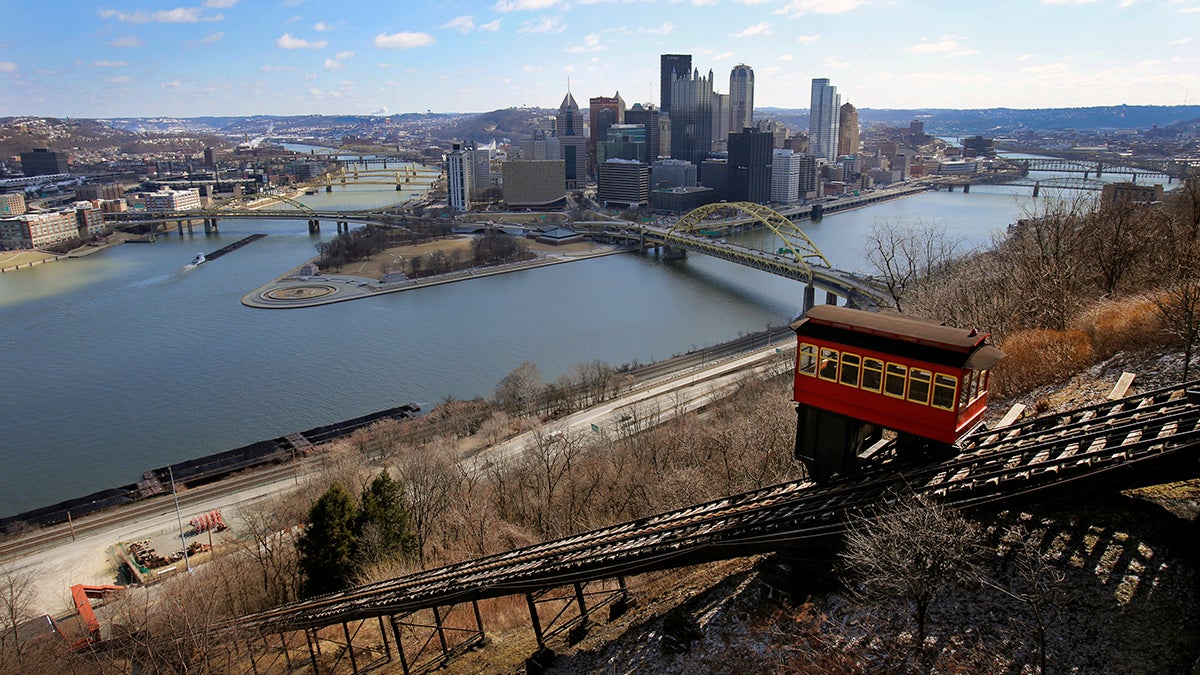You say aerial trams, we say inclines

The Duquesne Incline is one of two cable-propelled transit systems in Pittsburgh. Built in the 1870's
Call them gondolas, inclines, or aerial trams, but whatever you do, don’t call cable-propelled transit systems an infrastructure pipe dream.
Moving people from one place to another means traffic: highway jams, crowded buses, overworked subways; and let’s not get into the bike lane squabbles. But one transit option remains blissfully serene: cable-propelled transit systems.
It’s a broad category of conveyance that includes gondolas, aerial tramways, funiculars, and in western Pennsylvania, inclines: cars that move up and down a set of tracks, driven by cables.
The region boasts three inclines. Johnstown, Pa. bills its inclined plane — capable of carrying 60 people, six motorcycles, or a car — as the steepest vehicular incline in the world. In Pittsburgh, the Monongahela Incline and the Duquesne Incline daily tote a combined 2,500 people up and down the steep side of Mount Washington. On a nice, sunny day, or when the Steelers play, operators have seen the numbers climb as high as 5,000.
Adam Brandolph is spokesperson for the Port Authority of Allegheny County. He said the inclines have been a critical piece of the city’s transit system since they opened in the 1870’s.
“From an operations standpoint, it’s really easy to run. It only goes to two destinations: up and down.” But cable-propelled transit systems are hardly limited to being curiosities from a bygone era, said Steven Dale. He’s principal and founding president of Creative Urban Projects (CUP), an urban planning, research, and design studio in Toronto, Canada.
“By our estimates, we see it as being one of, if not the fastest-growing, transit technologies on the planet,” he said.
These cars on cables, whether suspended or on tracks, are good for topographical challenges such as rivers and steep hills. They take far less time and money to build than, say, a light rail line, and they can be highly effective feeder systems, closing tough gaps in transit networks. Dale adds there’s another, less tangible benefit.
“Would you rather be stuck underground in a vehicle that holds 200 people in the dark? Or up in the air in a vehicle of 10 people with a view that you’ve never seen before?”
Some might dismiss the systems as fanciful or a pipe dream, he said. But “any piece of public infrastructure in the western world is a pipe dream. The volume of things that are studied by government, and actually brought to fruition is a mere percentage,” said Dale. “This is not just a bunch of people coming up with a crazy idea. This is happening, and it’s spreading like wildfire throughout cities across the world.”
When Portland, Oregon built its aerial tram in 2007, it had been in the works for years, said Dylan Rivera, spokesman for the Portland Bureau of Transportation.
“It was really considered sort of far out there, if you will, to think of some sort of aerial transportation.”
But that dreamy Portland thinking led to a building boom by providing a critical link between a big, steep hill that housed the Oregon Health & Sciences University (OHSU) and the 100-acre former brownfield site south of downtown called South Waterfront.
“The Portland Aerial Tram was an incredible economic development tool for the city,” he said. The tram carries 9,000 people daily.
Cable-propelled transit systems are popping up around the globe, particularly in Latin America. And while it doesn’t look as though any Pennsylvania towns are currently considering plans to build one, you can get a sense of their potential by hopping on a Pocono ski lift.
WHYY is your source for fact-based, in-depth journalism and information. As a nonprofit organization, we rely on financial support from readers like you. Please give today.


